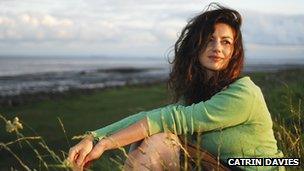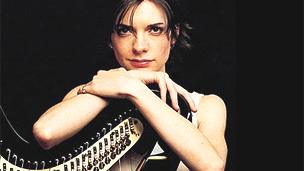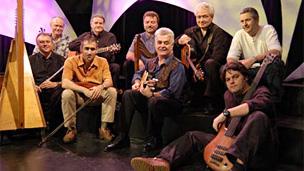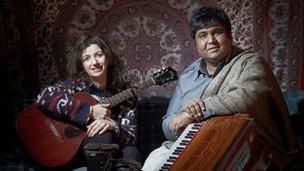Ten of the best: A history of Welsh folk music tradition
- Published
This week musicians and music industry leaders from across the globe are in Cardiff as WOMEX, external, the world's leading World Music Expo arrives in Britain.

Gwyneth Glyn has collaborated with some of Wales's leading musicians and performed all over the world
Each evening Cardiff Bay will become the venue for a world music Showcase Festival featuring a tapas of world music from around the world.
Folk music played a large part in this year's opening ceremony featuring Cerys Matthews and other leading Welsh musicians taking the audience on a journey of Welsh music and culture spanning 30,000 years.
We asked ten of the leading exponents of Wales' folk music to share songs that best represent what makes each tradition so unique.
1. The harp tradition in Wales
The earliest surviving manuscript of harp music in Europe - the manuscript of Robert ap Huw, external, comes from Wales.
"The tablature of the Ap Huw manuscripts provide a vital insight into early, traditional music and his music is still celebrated and performed widely" said internationally renowned harpist, Catrin Finch.

Catrin Finch is Britain's foremost harp performer and former Royal Harpist to Prince Charles.
"Caniad Y Gwyn Bibydd, external" (The Song of the White Piper) demonstrates his music's amazing ability to sound contemporary, even though it was written nearly five centuries ago."
2. Cerdd Dant
This unique tradition of singing or chanting poetry to harp accompaniment is a direct descendent of the form used by early bards to intone poetry in praise of their kings and princes.
Gwenan Gibard, external, a musician and leading exponent of the tradition chose the track Bum Yn Caru Cainc Y Datgeiniad, external by one of the old style singers, Einion Edwards, from Meirionydd - a stronghold of the tradition for centuries.
3. The Welsh Triple Harp
Considered by many to be Wales's national instrument, the triple harp was brought to Britain from continental Europe in around 1630. It became popular with harpists in London, many of whom were Welsh and brought it to Wales where it became popular amongst the Gipsy community.
"The 'shimmering' voice of the Triple Harp's three rows of strings is truly as timeless and unique as the Welsh language itself" said Robin Huw Bowen, external, a full-time professional Welsh harpist specializing solely in the Welsh Triple Harp.
The track Pwt Ar Y Bys, external (Fingering Vamp) shows off the harp's capability and the Welsh tradition to great effect.
4. The Plygain Service
In many parts of Wales Christmas Day meant attending an early plygain service between 3-6am at the parish church.
Singer Arfon Gwilym, external was brought up in the tradition and explains more: "The plygain tradition survives mainly in Montgomeryshire and takes place in churches and chapels over a six week period during Christmas and the new year."

The plygain is one of the oldest unbroken folk traditions in the British Isles.
"After a short service, the plygain is declared open and anyone in the audience can take part, as individuals or as small parties, the most common party being three people, singing in close harmony. The singing is always unaccompanied and in the past was dominated by men who sang in a simple folk style that was unique."
Listen to Ar Gyfer Heddiw'r Bore by Triawd Fronheulog, external.
5. Welsh folk songs and ballads
Welsh ballads are still widely performed in their traditional forms but new generations of musicians are revisiting them and performing the songs in more contemporary styles, ensuring they remain relevant. In recent years, folk singer Siân James, external has been at the forefront of this movement:
"A ballad which caught my imagination from a very young age was the very beautiful Yr Eneth gadd ei gwrthod, external (The rejected maiden) - a 19th Century ballad from the Cynwyd area near Bala, which tells the story of a young girl who, finding herself pregnant out of wedlock, is thrown out of her family home by her father, ostracised by her community and left destitute."
"It ends with the girl drowning herself. She is found with a water-sodden note in her hand, asking to be buried without a headstone, so her existence would be forgotten."
6. Wales' traditional dance reels
Due to the work of enlightened individuals such as Lady Llanover, external in the 18th Century, a good many of Wales' traditional dance reels (folk dance and accompanying dance tune type) have survived. Stephen Rees is one of Wales's leading folk musicians and musicologists:

Nansi Richards from Wales was known as the original 'Queen of the Welsh Harp'
"This recording of Pibddawns y Sipsi, external performed by Nansi Richards, the original 'Queen of the Welsh Harp' conveys the 'hwyl' or spirit of our traditional dance music."
7. Macaronic blends of Welsh and English
During the Industrial Revolution, migrant workers from across the world flocked to Wales' coalfields, slate quarries and docks. The impact on small, Welsh speaking communities was immense and this period ignited a tradition of mixed language songs known as Macaronic.
Cerys Matthews, external is a huge fan and chose Cân Merthyr, external as one of her favourites. Initially, Macaronic songs were thought to be an oral tradition but handwritten records do exist in the National Library of Wales archives dated 1909.
Its words are said to have been sold on the pamphlet of a ballad-singer at Merthyr Tydfil around the mid-19th Century.
8. Celtic folk revival
The 1960s and 1970s saw a surge in Welsh language activism. While the rest of the western world was engaged in the hippy movement and the 'summer of love', Wales was rediscovering its folk music and traditions, fuelled by a surge in the popularity of Celtic music.

Ar Log was Wales' first international folk band
"We formed Ar Log in 1976, with the dream of being able to earn a living solely by playing traditional Welsh music" said Dafydd Roberts, one of the founding members of Ar Log.
"By the early eighties Ar Log was travelling Europe and North & South America for around nine months of the year with a wealth of traditional Welsh folk music at our disposal, from haunting love songs and harp airs, to melodic dance tunes, and rousing sea shanties."
This medley of traditional folk songs comes from Ar Log's own repertoire: Twll yn y to / Cymro o Ble / Pedwar Post y Gwely, external
9. Protest songs
Dafydd Iwan is a singer-composer and political activist and campaigned during the 1960s, 1970s and 1980s for official status for the Welsh language with Cymdeithas Yr Iaith, the Welsh Language Movement, external.
"Songs have been a natural medium for expressing strong emotions and political protest for centuries, and here in Wales there is a long tradition of ballads with a strong social and political theme," he said.
Peintio'r Byd Yn Wyrdd, external (Painting the world green) grew out of the road-signs campaign for the Welsh language.
10. Experimentation and collaboration
More and more young musicians are turning to the folk tradition for inspiration and helping to drive creative experimentation and collaborations.

Ghazalaw consist of Mumbai Ghazal singer Tauseef Akhtar and Cardiff-based Welsh singer-songwriter Gwyneth Glyn.
Welsh poet and singer-songwriter Gwyneth Glyn, external has recently been working on such a project with musicians from India and singer Tauseef Akhrar from Mumbai and incorporates Indian violin, tabla and Welsh harp.
Another recent project entitled Mamiaith (Mother Tongue), saw Welsh folk group 9Bach, external collaborate with Australian group Black Arm Band, external to explore the poignant theme of lost language. Gwyneth chose the track Cariad Mam, external (Mother's Love) from that album.
Today, musical tradition in Wales is thriving as younger musicians turn to folk music for inspiration but continue to develop it further with rich musical collaborations around the world.
WOMEX - The World's Music Comes To Wales is broadcast on BBC Two Wales, Sunday 27 October at 22:00 BST.
- Published24 October 2013
- Published23 October 2013
- Published23 October 2013
- Published21 October 2013